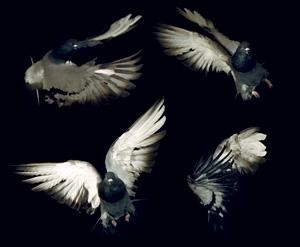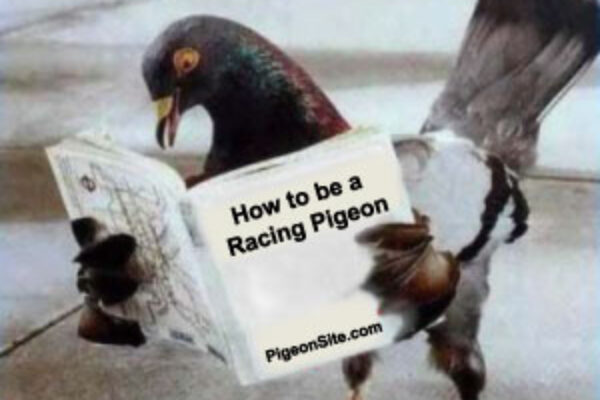 To be able to breed winners we need to understand the factors or attributes that determine the ability of any pigeon to win races. Tackling the problem from a slightly different angle than usual, may help us to arrive at an answer more readily. Finding the essential truth about winners may require some dissecting so that the winner’s image is tripped of all distracting red herrings, leaving only the essential necessities.
To be able to breed winners we need to understand the factors or attributes that determine the ability of any pigeon to win races. Tackling the problem from a slightly different angle than usual, may help us to arrive at an answer more readily. Finding the essential truth about winners may require some dissecting so that the winner’s image is tripped of all distracting red herrings, leaving only the essential necessities.
These must be ‘cast in concrete’, never to be shifted and they form the foundation for all future breeding attempts. To create winners we must then ‘rebuild’ the pigeon, using a retrogressive process, beginning with the bare essentials. The red herrings referred to above, are all the non-essential features that make up winners. First we must find and concentrate on the essential factors – the ones without which no pigeon can be a winner. What these are, is the prime purpose of this article.
Before going further, we must re-iterate to perceptions about winning, so that all the readers are agreed in their understanding of the term.
The first consideration
Involves one of the fundamental truths of pigeon racing, which is that in all races there are followers and leaders. Identifying true leaders is not difficult as their results in racing proclaim them to be what they are. Followers are more difficult to find. These are the birds that occasionally stay in the leading pack and sometimes win races. The repeatability of their performance is the clue to their status. Should any winner fail on other occasions to repeat its winning performances, it most likely is a follower and ought to be removed from the team at the first opportunity.
The second perception
Is that all the birds racing in a group are classified as winners if they are part of the first group to enter the area near their lofts. It is important that all birds, even if there are ten or twenty in the leading pack, are recognised for their abilities provided that the first consideration above is understood. The argument is that a pigeon from the first group (batch or pack) which won the 20th place in a race, performed equally as well as the one that flew first or second. The influence of position and drag, caused wind, water masses, mountains and so on, are thus deliberately ignored.
Attributes of a winner
So what does it take to be a winner? For the sake of simplicity let us look only at middle distance winner i.e. those birds that win from about 400 to 600 kilometres on days without wind. Remember that these birds are most likely to be successful at this distance which does not mean they will win exclusively in these races not does it necessarily mean that they cannot win either a tail- or headwind races. Our next step is the process of elimination to identify and remove the red herrings. Let us take the physically observable systems one by one and discuss their role.
Wings
Wings are necessary; no one denies that but is any wing more adequate than another? After having examined thousands of pigeons, some of which were successful and others less so, it appears to me that a few essential features are found in the winners. Unfortunately for the wingmen, those self-same features can be found on non-winners. Exceptions do occasionally occur.
Muscle
A Supple musculature is usually seen on all the winners… but alas, also on some non-winners. Why ‘usually’? Because, on occasion, the musculature of the winning pigeon feels doughy and heavy, not at all the required spongy, resilient and weightless type.
Other physical parts
As generally advocated, winning birds are usually well balanced with a firm constitution with the back and tail as one whole, the tail neither lifting nor dragging. But again there are exceptions and one stand amazed at the physical variations that occur.
Let us deal with the exceptions first. If good pigeons must have a certain wing design, muscle type or other body essentials, how can it be that pigeons that do not conform also win races? This has often puzzled many fanciers and obscures the quest for winners. The answer is to be found in COST. The cost of a winning performance is to be found in the recovery period, which is sometimes dramatically extended. This cost is always heavier for the ill-equipped winner.
As repeatability of performance is so instrumental in deciding the worth of a racer it follows that the winner must be able to recover quickly from his excertions and be ready to compete again. The winner with imperfections has the correct mindset but is not able to repeat his performance so soon! Because of his/her shortcomings, racing successfully required that more effort that would have been the case had it been better equipped for the task.
The EYE
Finally we come to the eye. Is the eye at all instrumental in deciding the racing worth of a pigeon or not? We all agree that a bird needs a good eyesight, but is there any feature beyond that, which would help it to perform better that its competitors? If NO, we do not have to consider the eye any longer but if the answer is YES, how could it influence racing?
Could it be that something in the eye strengthens the pigeon’s homing capabilities? Of all the possibilities, this is the most likely but that feature would then only make it a good homer and we need racers, not homers.
Could it be that this special feature, whatever it is, could encourage the pigeon to hurry in its return home i.e. strengthen the desire to return as soon as possible? Why? And How? It would be a valuable aid provided that the bird found the right way home.
Could the eye feature facilitate the speed of flying? It is difficult to imagine that a feature could influence the speed of racing, which is largely under muscular control, as features found in the eye.
Could it be that this feature increases the strength, capability and endurance to return home? It is difficult to see how any feature in the eye could have and influence on the muscle strength and staying power.
A nebulous haze of contradictions and arguments surrounds the recognition of this magic feature in the eye. The eye theory was first postulated more than a century ago by Gigot but it was SWE Bishop who revived the belief.
Recently the cudgels have been taken up by Carney in the UK and locally by Barkel in South Africa. There are many others all over the world. Joyce in South Africa did an in-depth study of the eye and could find no further evidence other that an increased pigment, which seemed to be positively correlated to major winners.
The great paradox
The great paradox is that though both Carney and later ‘experts’ proclaimed to have discovered the secret – in the eye – of good racers or breeders, yet they did not always describe the same feature. Whereas Bishop found his answer in the so-called eyesign and did not make any reference to the innermost pigmented circle lying around the circumference of the pupil, I have heard today’s eye experts base their complete hypotheses on this structure!
Carney, Barkel and others devide the eye into five circles and base their opinions in the relative strength, presence or absence of these circles. Many others have their ideas, beliefs and theories and have given different names to the structures seen in the iris. The only common denominator is that all find the answer to their quest in the iris of the eye. Could be that all or any one of them is right?
Other phenomena, identified in the search for the perfect racer, have been noted but not seriously considered. The consequences of their presence or absence if however, similar to the main features discussed above.
Breeding
Breeding is a relatively easy exercise when physical measurable features can be selected for. Employing strict selection standards and with the rapid turnover rate in pigeon breeding colonies, the desired physical properties can be relatively easily fixed in the family. (This also applies to any property of the eye.) As an example one need look no further than the various fancy pigeon breeds or the hundreds of man-made chicken breeds. It begs the question; why has there been such relatively slow progress in racing pigeon breeding?
The answer lies in the fundamental truth that the MENTAL CAPABILITIES ARE MORE IMPORTANT THAN THE PHYSICAL. Without the correct mental make-up no pigeon can ever be a leader. Even if it had all the physical requisites to be a champion racer, without a clear ‘knowledge’ of the homeward direction and a strong desire to be at that home, they would be worthless. And thus we arrive at the basic fundamental essential of all racing pigeons; it is a combination of all the mental capabilities i.e. the homing ability, ‘will-to-win’, obstinacy of endurance etc. All rolled into one and described as the ‘mental capabilities’. This must form the solid foundation on which our whole breeding effort is to rest.
And where do we look to find this solid foundation? The Pedigree!
The pedigree is a description of the family but is worthless if the achievements of the immediate ancestry are not recorded. Again I must remind fanciers that a pedigree takes on many forms. It can be verbal. For instance, if a pigeon is bought and the buyer is told about or shown the parents, grandparents and their accomplishments it is a fully acceptable pedigree – although no paper was involved.
But be careful, every pigeon on earth has a pedigree. All have parents and grandparents – so as such, whether written or not, a pedigree is useless and only when the racing and/or breeding achievements of the forebears are included does it become something valuable. On the other hand if you were given a pair of offspring of, let’s say, “Kleine Didi” and with no other information, it still qualifies – because everyone knows the achievements of “Kleine Didi” – in this instance nothing is written but a full pedigree is there!
A final question: “Why is the pedigree so important?”
Because breeding is a numbers game. If the pedigree supports many winners amongst the ancestors, the chances improve regarding the possibility of they’re being winners amongst the offspring. It is an accepted fact that it is better (i.e. the chances of success improve), to breed from a mediocre bird below the average of his outstanding family, than relying for success on an outstanding bird from a mediocre family, above the average of his family.
For those that would breed winning racing pigeons therefore first go to the family i.e. ascertain whether there are winners (and how many against what competition!) amongst the immediate family. Then proceed to select according to the physical features, taking care that the winning mentality is never ever lost.
I wish you the best of luck.
Dissection of a Winning Racing Pigeon by Dr. Wim Peters.








HI
Very good information ,
pigeon must have good pedigree.
Good luck